Great Dane
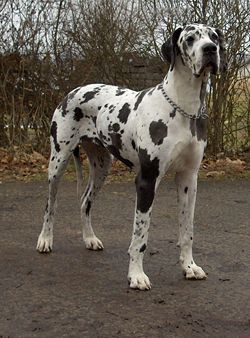 A harlequin Great Dane |
||||||||||||||||||||||
| Other names | Grand Danois (Old French: "Great Dane" the modern French is Dogue Allemand ("German Mastiff"). Deutsche Dogge ("German Mastiff") Dänischer Hund ("Danish Hound")[1] |
|||||||||||||||||||||
|---|---|---|---|---|---|---|---|---|---|---|---|---|---|---|---|---|---|---|---|---|---|---|
| Nicknames | Dane Gentle Giant |
|||||||||||||||||||||
| Country of origin | Germany | |||||||||||||||||||||
|
||||||||||||||||||||||
|
||||||||||||||||||||||
The Great Dane, Danish Hound, or German Mastiff, is a breed of domestic dog (Canis lupus familiaris) known for its giant size and gentle personality.[2] The breed is commonly referred to as the "Gentle giant" and the "Apollo of all breeds."[3] Great Danes are considered one of the tallest dog breeds along with the Irish Wolfhound. More recently, Great Danes have been in the Guinness World Records for tallest dog. The Great Dane was named the state dog of Pennsylvania in 1965.[4]
Contents |
Description
Appearance
In the United States, the breed standard for the Great Dane is described on the American Kennel Club website. [5] The male should appear more massive throughout than the female, with larger frame and heavier bone. In the ratio between length and height, the Great Dane should be square. In females, a somewhat longer body is permissible, providing she is well proportioned to her height. Coarseness or lack of substance are equally undesirable. The male shall not be less than 30 inches (75 cm) at the shoulders, but it is preferable that he be 32 inches or more (>80 cm), providing he is well proportioned to his height. The female shall not be less than 28 inches (70 cm) at the shoulders, but it is preferable that she be 30 inches or more (>75 cm), providing she is well proportioned to her height. Danes under minimum height must be disqualified. There used to be a minimum weight requirement, but the current standard does not call for this.[6]
In August 2004, a Great Dane named "Gibson" from Grass Valley, California was recognized by the Guinness Book of Records as the world's tallest dog, measuring 107 cm (42.2 in) at the withers.[7] It is not in the best interest of the breed to attempt to achieve the "tallest" dog. Breeding for height will sacrifice structure and conformation in the Great Dane and produce dogs that are unsound.
Coat colors
There are six show-acceptable coat colors for Great Danes:[8]
- Fawn: The color is yellow gold with a black mask. Black should appear on the eye rims and eyebrows, and may appear on the ears and tail tip.
- Brindle: The color is fawn and black in a chevron stripe pattern. Often also they are referred to as having a tiger-stripe pattern. White markings at the chest and toes are not desirable and considered faults.
- Blue: The color is a pure steel blue. White markings at the chest and toes are not desirable and considered faults.
- Black: The color is a glossy black. White markings at the chest and toes are not desirable and considered faults.
- Harlequin: The base color is pure white with black torn patches irregularly and well distributed over the entire body; a pure white neck is preferred. The black patches should never be large enough to give the appearance of a blanket, nor so small as to give a stippled or dappled effect. Eligible, but less desirable, are a few small grey patches (this grey is consistent with a Merle marking) or a white base with single black hairs showing through, which tend to give a salt and pepper or dirty effect.
- Mantle (in some countries referred to as Bostons due to the similar coloration & pattern as a Boston Terrier): The color is black and white with a solid black blanket extending over the body; black skull with white muzzle; white blaze is optional; whole white collar preferred; a white chest; white on part or whole of forelegs and hind legs; white tipped black tail. A small white marking in the black blanket is acceptable, as is a break in the white collar.
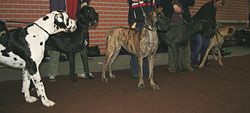
Other colors occur occasionally but are not acceptable for conformation showing, and they are not pursued by breeders. These colors include white, fawnequin, merle, merlequin, fawn mantle, and others. These are sometimes advertised as "rare" colors to unsuspecting buyers.
Cropping of the ears is common in the United States and much less common in Europe. In some European countries such as the UK, Denmark, Germany, parts of Australia, and in New Zealand, the practice is banned, or controlled in such that it may only be performed by veterinary surgeons for health reasons. The original purpose of Ear Cropping was to cut the ears so that wolves and wild boar (often the objective of great dane hunts) would not be able to grab a hold of the ear. Now, however, it is used to obtain a more regal or majestic look in showdogs. The original ear cropping can be seen in the pictures below.
Temperament
The Great Dane's large and imposing appearance belies its friendly nature; the breed is often referred to as a gentle giant. Great Danes are generally well-disposed toward other dogs, other non-canine pets, wild animals, and humans (including strangers and children). Some Great Danes — as with dogs of any breed — may have dominance issues, may be aggressive with other dogs of the same sex, or chase small animals; however, this is quite rare.[9]
Exercise
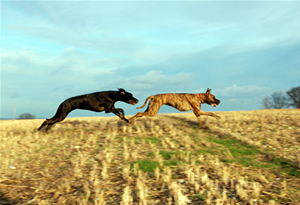
Although Great Danes have a fairly slow metabolism they need daily exercise the same as any other dog, and a fair amount of it.
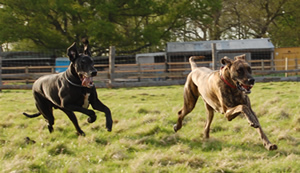
A common misconception is that they are all slow and docile and don't need walking, this is incorrect and in most cases Great Danes are full of energy and need regular walking.
Health
Great Danes, like most giant dogs, have a fairly slow metabolism. This results in less energy and less food consumption per pound of dog than in small breeds. Great Danes have some health problems that are common to large breeds. Bloat (a painful distending and twisting of the stomach formally known as Gastric volvulus) is a critical condition that can affect Great Danes and results rapidly in death if not quickly addressed. Drinking large amounts of fluid in a short period of time can provoke Bloating in Great Danes, as well as other larger breeds of dogs. It is a commonly recommended practice for Great Danes to have their stomachs tacked (Gastropexy) to the right abdominal wall during routine surgery such as spaying or neutering if the dog or its relatives have a history of bloat, though some veterinary surgeons will not do the operation if the actual sickness has not occurred. Elevated food dishes are often believed to help prevent bloat by regulating the amount of air that is inhaled while eating, although one study suggests that they may increase the risk.[10] Refraining from exercise or activity immediately before and after meals may also reduce risk, although this has not been validated with research.
Another problem common to the breed is hip dysplasia. Typically an x-ray of the parents can certify whether their hips are healthy and can serve as a guideline for whether the animals should be bred and are likely to have healthy pups.
Great Danes generally live 8-10 years, but with responsible breeding and improved nutrition they can live to be 12-14.
Dilated cardiomyopathy (DCM) and many congenital heart diseases are also commonly found in the Great Dane.
Great Danes also suffer from several genetic disorders that are specific to the breed. For example, if a Great Dane lacks color (is white) near its eyes or ears then that organ does not develop and usually the dog will be either blind or deaf.[11]
History
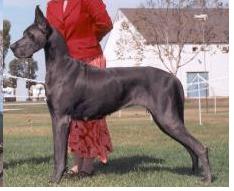
Some sources state that dogs similar to Great Danes were known in Ancient Egypt, Greece and Rome.[12][13] Various sources report that the Great Dane was developed from the medieval boarhound, and of the Mastiff and Irish wolfhound lines.[12][14] It is also reported that the Great Dane was developed from mastiff-like dogs taken to Germany by the Alans.[15] The breed may be about 400 years old.[13] The Bullenbeisser may be its direct ancestor, composing about the 40% of its make-up.
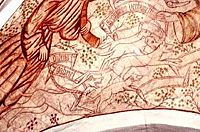
According to Barbara Stein, "The breed originated in Germany, probably from a cross between the English mastiff and the Irish Wolfhound." [16] However, other sources maintain that the breed originated in Denmark,[17] and still others report the question as controversial and unsettled.[1]In 1749 Georges-Louis Leclerc, Comte de Buffon [18] used the name ”le Grand Danois,” (translated by William Smellie (encyclopedist) as ”Great Dane”). Up until that time the hound was referred to in England as ”Danish dog.”[19]
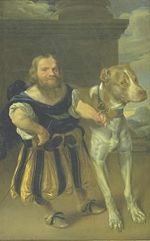
According to Jacob Nicolay Wilse the Danes called the dog ”large hound,” a terminology continued well in to the 20th Century.[20]

In Germany in 1780 the hound is referred to as ”Grosse Dänische Yagd Hund” (English: Large Danish Hunting Hound).[21] At the first dog exhibition, held in Hamburg 14-20 July 1863, eight dogs were called ”Dänische Dogge” and seven ”Ulmer Doggen.”[22]
There is, without a doubt, no more curiosity in dog breed names than in the Great Dane. However, it can be clearly traced back that this breed originated in Germany, not in Denmark as often mistaken by its Anglo Saxon name. The reason why in Anglo Saxon and French speaking countries refer to the German Mastiff still as Great Dane are political reasons of historical issues especially during the unification of Germany by Prussia and Bismarck. In the Holy Roman Empire of German Countries this breed had many names and not a united one. The variety of names were depending on its origin. The oldest trackable breeders were in the Wuerttemberg Region and Hessian Region of Germany. All regions had they favourite colour of coat. This led to the confusion during the first dogs breeder exhibition in Germany in 1863 that breeders from all different areas signed in this breed with its local name although it was the same breed. When it was decided during the German Dog Exhibition in Hamburg Altona that they should be a united name for this old German breed it was decisive that this dog would be called "Deutsche Dogge" (German Mastiff) at a time when Germany united and Prussia became a European Power in defeating France. Therefore it is clear that Britain or France would not call a dog " Great German".The precursors of todayís Great Dane are the old "Bullenbeisser" as well as the so-called "Hatz- and Sauhunde" (hounds), which are a cross between the strong Mastiff of the English type and a fast and nimble Greyhound. At first, big and strong dogs that did not necessarily belong to a certain breed were considered as Danes. Later on, names like Ulmer Dane, English Dane, Danish Dane, "Saupacker" (wild boar hunt) and big Dane described the different sizes and colors of this type. In 1878 a committee of seven, consisting of committed breeders and judges with the chairman Dr Bodinus, decided in Berlin to unite all varieties of the above-mentioned types under the term "Deutsche Dogge" (German Dane, ie Great Dane). Through this the foundation for the first German dog breed has been laid. In 1880, on the occasion of a dog show in Berlin, a standard for the Great Dane was determined for the first time. Since 1888, the "Deutsche Doggen Club 1888 e.V." is in charge of this standards and repeatedly modified it since. Today's edition fulfills the demands of the F.C.I.
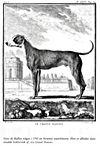
References
- ↑ "Es war ein reizender Abend," short story by Erich Kästner.
- ↑ Frederick Becker,The Great Dane - Embodying a Full Exposition of the History, Breeding Principles, Education, and Present State of the Breed (a Vintage Dog Books Breed Classic): Embodying a Full Exposition of the History, Breeding Principles, Education, and Present State of the Breed, Published by READ BOOKS, 2005, ISBN 1905124430.
- ↑ Great Dane, The Online Dog Encyclopedia, www.dogsindepth.com
- ↑ State Symbols USA, www.statesymbolsusa.org
- ↑ www.akc.org
- ↑ Cunliffe, Juliette (2005). The Complete Encyclopedia of Dog Breeds. UK: Parragon Publishing. ISBN 1-40544-389-8.
- ↑ "Tallest Dog Living". Guinness World Records (2004-08-31). Retrieved on 2008-05-21.
- ↑ "Great Dane Breed Standard". American Kennel Club (1999). Retrieved on 2008-05-20.
- ↑ Great Dane: A Comprehensive Guide to Owning and Caring for Your Dog, Kennel Club Book, 2003, ISBN 159378273X
- ↑ Journal of the American Veterinary Medical Association, Non-dietary risk factors for gastric dilatation-volvulus in large and giant breed dogs
- ↑ "Great Dane rescue a labor of love", by Tamara Phillips, March 23, 2008, Daytona Beach News-Journal.
- ↑ 12.0 12.1 Great Dane - URL retrieved August 29, 2006
- ↑ 13.0 13.1 The Great Dane - URL retrieved August 29, 2006
- ↑ Great Dane at Kaynine Online - URL retrieved August 29, 2006
- ↑ Great Dane - URL retrieved August 29, 2006
- ↑ Collier's Encyclopedia, 1993, sv Great Dane
- ↑ "The Great Dane – A Danish Cultural Heritage." Great Danes: House of Apollon.
- ↑ ”Histoire Naturelle, générale et particulière”
- ↑ "Canine Madness,” 1762).
- ↑ ”Fuldstændig beskrivelse af stapelstaden Fridericia – efter pålidelige underretninger og egne undersøgninger.” 1767, p176
- ↑ Edward C. Ash : Practical Dog Book, 1931, ”The Great Dane")
- ↑ Bulletin Officiel de la Société Canine de Monaco, August 1937